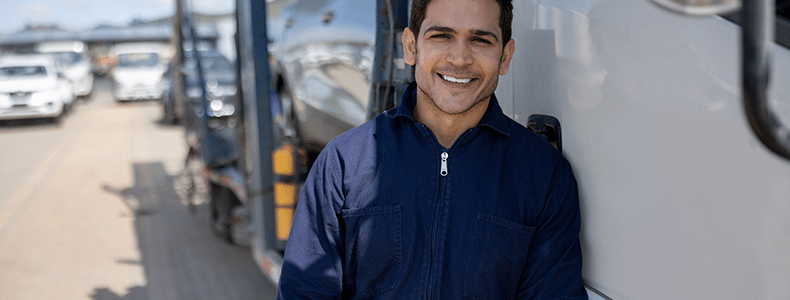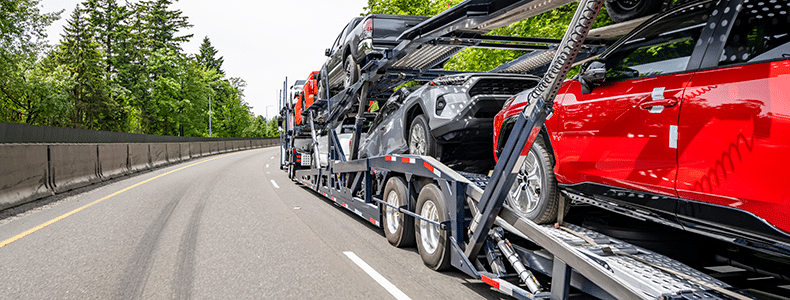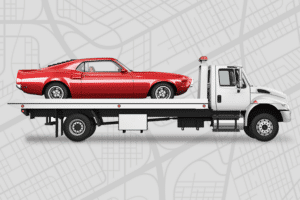Transporting your car is more than just moving it from point A to point B—it’s about protecting a significant piece of your lifestyle. It’s natural to feel a bit apprehensive about entrusting your ride to someone else. However, arming yourself with the right information can help you navigate the vehicle shipping process with confidence and ease.
In this guide, we’ll cover:
- How to spot trustworthy car transport services
- The benefits and drawbacks of different transport options, like open vs. enclosed trailers
- Essential tips for a smooth car transport experience
- Strategies to avoid common pitfalls and ensure a stress-free move
Learn everything you need to confidently approach car transportation. We’re here to help you decode the industry’s lingo and simplify its complexities, making sure you’re prepared for every step of the journey.
#1. CHOOSE A TRUSTWORTHY CAR TRANSPORTER

Moving your car to a new house might seem a bit scary at first, especially if you haven’t done it before. Don’t worry! If you follow these easy steps, you can find a company that will help you move your car safely and without any stress.
STEP 1: RESEARCH CAR TRANSPORTER COMPANIES. Look online to see what other people say about their service. Make sure to check if they are usually on time, if they talk to you clearly, and if their customers are happy.
STEP 2: MAKE SURE THE COMPANY IS GENUINE and allows cars to be moved to different locations. It needs to have a special number from the Department of Transportation (DOT). Also, check to see if it is a member of large groups such as the American Auto Transport Association (AATA) and the Better Business Bureau (BBB). This means it promises to be honest and fair.
STEP 3: ASK YOUR FRIENDS AND FAMILY FOR ADVICE. If they have previously moved cars with a company, they can tell you about their experience. This can help you choose faster and easier.
STEP 4: GET PRICE QUOTES FROM DIFFERENT COMPANIES. Ask how much it will cost to move your car. Compare these prices to see which one is the best deal for you without sacrificing good service. uShip makes this easy to do on one platform.
STEP 5: TALK REGULARLY WITH THE CARRIER YOU PICK. This means having conversations often to build trust and ensure you’re not worried. You can ask any questions or tell the company about your worries. A good company will always listen to you and try to meet your needs as best it can.
#2. PREPARE FOR VEHICLE SHIPPING
Before you ship your car, it’s a good idea to clean it thoroughly, both inside and out.
Make sure to take detailed photos of every part, especially areas that are easily damaged, like the doors, bumpers, and wheels. Documenting your car’s condition with photos and notes serves as proof of its state before vehicle shipping.
Next, clear out all your personal stuff from the car. Remove everything from bags and tools to even the smallest items. If you leave things inside, there’s a higher chance they could get lost or broken during the move. Also, check for any parts that might be loose, like antennas, mirrors, or spoilers. It’s best to secure these parts tightly, or you might even consider removing them to avoid any issues during transport.
For example, shipping an old convertible without securing the soft top could end up damaging the fabric, which would decrease the car’s value. Taking care of these little details might seem trivial, but they can save you a lot of money and hassle in the long run.
Lastly, make sure you understand the carrier’s insurance policy. Know what coverage you have and think about getting additional protection if necessary. Being well-prepared is key to ensuring a smooth vehicle shipping process.
#3. REVIEW INSURANCE COVERAGE
Navigating the jargon-filled waters of auto shipment insurance doesn’t have to leave you feeling lost. Here’s a quick rundown of tips to help you comprehend your coverage choices.
Start by learning about the common types of insurance used in vehicle transportation. Liability insurance is compulsory; it pays for third-party property damages. Comprehensive insurance offers broader protection, shielding your own vehicle from damages like theft, vandalism, or weather events.
Remember, standard policies sometimes fall short. They may neglect to fully cover custom parts, modifications, or expensive vehicles. Here’s where additional protection from uShip comes into play, a savvy choice for enhanced protection.
Imagine you own a $75,000 classic muscle car. Though the baseline insurance might insure the car for its market value, it probably wouldn’t pay for repairs to customized parts. By choosing additional protection for collectibles or luxury autos, you’d gain complete protection for the whole vehicle and its distinct attributes.
#4. SELECT THE RIGHT VEHICLE SHIPPING METHOD
If you want to make sure your valuable car is safe and secure during the shipping process, you need to carefully choose the best way to ship it. There are mainly two choices: open trailers and enclosed trailers. Let’s talk about the things that make you choose one of these two methods over the other.
Starting with open transportation, this choice saves money because it lets more than one vehicle travel on the same trailer. Driving an open truck exposes your car to elements such as rain, snow, sun, and road debris. However, experienced carriers use side rails and protective netting to keep people from getting too close. Open transport works for regular cars, especially ones that aren’t collector’s items or show cars.
On the other hand, enclosed transport makes a cozy cocoon for your vehicle, protecting it from bad weather and outside dangers. For rare, old, or expensive cars where keeping the original paint jobs and finishes is important, this method is best. Trailers with covers have climate control systems that keep temperatures from changing too much, which can damage delicate materials like leather seats.
How do you then pick the method that works best for you? First, think about the following things:
- The value of your car: Enclosed trailers are a good idea for high-end, rare, or one-of-a-kind cars that need extra protection.
- The shipment’s distance: Protecting your vehicle from damaging elements is more important on longer trips.
- Timeline: There aren’t as many open spots for enclosed trailers as there are for open trailers, which makes them less flexible when it comes to scheduling.
- Cost: In general, open transportation costs less than enclosed transportation.
- The time of year: The weather determines the best way to ship things. When the weather is bad, enclosed trailers are the best way to keep everyone safe.
- Personalization: Enclosed trailers can handle the extra care and attention needed for modifications or unique features.
#5. SCHEDULE SHIPPING IN ADVANCE
There are many benefits to planning your shipping and figuring out when to move your car ahead of time. Planning ahead will make the process go more smoothly and save you from the chaos of making plans at the last minute and the problems that may arise.
Plan your vehicle shipping ahead of time to get the best loading and unloading dates. This proactive approach also gives you plenty of time to find reputable carriers, compare quotes, and agree on terms that are good for both parties. Additionally, booking in advance grants you priority, reducing the likelihood of delays due to limited space or equipment.
Planning your shipment ahead of time also gives you peace of mind, allowing you to focus on other moving-related logistics. You won’t have to worry about what will happen if you wait until the last minute and things go wrong. Knowing that your car is safely on its way to its new home will bring you happiness. You can save time and make things easier for yourself by shipping your car a long time before you want to leave.
#6. COMMUNICATE CLEARLY WITH THE CARRIER
Effective communication between you and your chosen car transporter creates the foundation for a smooth experience. Establishing open lines of communication promotes transparency and trust, and confronts any potential issues head-on.
When sharing pickup and delivery locations, be specific, including detailed address information, phone numbers, and access restrictions. Accurately communicating these critical details avoids misunderstandings and miscommunications, which could result in unnecessary delays or inconvenience.
Addressing any concerns or special instructions ahead of time saves time and resources for everyone involved. Perhaps your vehicle has nonstandard dimensions or requires special handling procedures. By openly discussing these requirements with your carrier, you show respect for their expertise while ensuring that your expectations are in line with their capabilities.
Clear communication also entails staying up-to-date on your vehicle’s status throughout the vehicle shipping process. Regularly checking in with your carrier keeps you informed about any changes or adjustments, giving you a sense of control during the transition.
Embracing open and transparent communication with your service provider paves the way for a successful collaboration based on mutual understanding, trust, and shared goals. So, start meaningful conversations, ask questions, and collaborate to create a positive vehicle shipping experience.
#7. INSPECT THE VEHICLE UPON DELIVERY
Always make sure the vehicle is in perfect working order before you accept delivery of the keys. Performing a thorough examination helps to identify and document any existing damages or discrepancies, which can help to avoid disputes or misunderstandings in the future.
As you go around the vehicle’s exterior, look for dings, scratches, and chipped paint. The undercarriage, wheel rims, and tires are common places for unseen damage, so be sure to inspect them thoroughly, as well as seals, glass, controls, and trim. Take pictures, write down every detail you find, and make note of the odometer reading and its condition.
Call the driver or carrier agent right away if you find any damage or discrepancies. While providing them with your documentation, discuss possible solutions. By keeping communication lines open, you can show that you are committed to being fair and honest while also facilitating a quick resolution.
Performing a thorough inspection upon receiving your vehicle goes beyond simply finding damages; it also helps build trust and confidence in the carrier company. By taking charge of the inspection process, you can establish a solid business relationship based on honesty, reliability, and professionalism.
#8. UNDERSTAND THE SHIPPING CONTRACT
You should begin by carefully reading the contract and noting all of the terms and conditions. You know that the carrier is responsible for damages, but you are also responsible for making sure your vehicle is ready and reachable. Carefully review the terms and conditions for any extra services, like storage or expedited shipping.
Next, get the cancellation policies and payment terms straightened out. Installment plans and upfront payments are two examples of the many possible payment formats. You should be well-versed in the due dates and penalties for nonpayment. Also, look into what happens if you cancel the contract too soon. Will there be monetary consequences? If the carrier is unable to meet the agreed-upon deadline, what will happen?
Feel free to ask questions if you need clarification. Talk to your carrier representative and ask for clarification on any terms you don’t understand or clauses that aren’t clear. Do not be shy about asking questions; their goal is to make sure you are comfortable with the contract.
Regulatory agencies and trade groups are another good source of information. Regulatory bodies such as the Federal Motor Carrier Safety Administration (FMCSA) and the American Trucking Associations (ATA) conduct studies and issue rules and regulations to safeguard customers and encourage moral company practices.
In the end, read reviews and testimonials posted online by people who have used the service before. Find out what others have experienced, both good and bad, with the same shipping contract. Knowledge allows you to confidently and easily navigate the car shipping landscape. Remember, knowledge is power.
#9. UNDERSTAND THE BILL OF LADING
The Bill of Lading serves as a contractual agreement between the shipper (the person sending their vehicle), the carrier (the company responsible for moving the vehicle), and the consignee (the vehicle’s recipient). The contract outlines the transportation terms and conditions, detailing the vehicle’s type, make, model, and condition, along with the agreed-upon price, payment terms, and delivery schedule.
Certain provisions in the Bill of Lading may be particularly relevant for those shipping cars. These include clauses related to insurance coverage, loading and unloading procedures, and damage claims. Ensuring you fully understand these aspects can help protect your interests throughout the shipping process.
Moreover, the Bill of Lading serves as a valuable document for customs clearance at the destination port. Accurately completing sections pertaining to the vehicle description, origin, and intended use can expedite your car’s release from customs, saving time and reducing hassle upon arrival.
Lastly, from a grammatical standpoint, it is important to note that errors or inconsistencies in the Bill of Lading could lead to complications down the line. Mislabeled vehicle descriptions, incorrect weights, or poorly written contracts might result in delayed deliveries, additional costs, or even disputes between parties. Therefore, double-checking all relevant information before signing off on the final version is imperative.
#10. FOLLOW UP AND PROVIDE FEEDBACK
Your involvement in the car shipping process does not conclude with the final handshake; it follows your vehicle as it makes its way to its destination. Improving the customer experience and influencing the auto transport industry’s future are direct results of thoughtful reviews, constructive criticism, and expressions of gratitude.
Give your carrier a round of applause for a job well done. Let the company know how much you appreciate them publicly through social media, online forums, or even just simple communication. Word-of-mouth recommendations carry immense weight, inspiring confidence in potential clients and fueling growth.
Just keep in mind that honest dialogue is essential for fixing errors and enhancing procedures when problems emerge. If you are unhappy with the service you received from your transporter representative, please let them know clearly to get solutions.
Then, post in-depth evaluations on reputable third-party sites like Google My Business, Yelp, or Transport Reviews. Readers can learn a lot about a company’s reliability and quality from reviews, which in turn helps other people make better purchasing decisions. While writing a review, make sure to include concrete examples of either great or bad experiences. This will help others understand your perspective.
We cannot overstate the importance of providing feedback. It helps people connect, propels progress, and gives them the power to make smart decisions. Your active engagement in the post-shipping process fosters a vibrant ecosystem of happy customers, committed professionals, and growing businesses.

COMMON QUESTIONS PEOPLE ALSO ASK (PAA)
How much does it cost to ship a car?
The cost to ship a car varies depending on several factors, including the distance, size, and weight of the vehicle, the chosen vehicle shipping method, and current market rates. Contacting reputable auto transporting companies and sharing your car’s specifications will help you obtain an accurate quote.
How long does it take to ship a vehicle?
The duration of vehicle shipping can range from a few days to a week for domestic transports and up to 6 weeks for international ones. Keep in mind that these estimates may fluctuate due to vehicle shipping methods, routes, and customs clearance processes.
Is the vehicle safe to ship?
Yes, car shipping is generally safe when handled by competent and experienced auto transport providers. They utilize specialized equipment to ensure secure loading, transport, and unloading. Many companies also offer insurance coverage to safeguard against damages during transit.
What are the different types of car shipping services?
There are primarily three types of vehicle shipping services: open carrier transport, enclosed carrier transport, and expedited shipping. Open carrier transport involves sharing space on an open trailer with other vehicles; enclosed carrier transport offers individual covered trailers for enhanced protection, and expedited shipping ensures faster turnaround times.
How do I prepare my car for shipping?
Prepare your car for shipping by performing a thorough inspection, cleaning the exterior, removing personal belongings, draining fuel levels, disconnecting battery cables, and setting appropriate tire pressures. If you need any additional suggestions based on your specific situation, consult your transporting provider.
Can I track my vehicle during transport?
Most reputable car hauler companies provide online tracking systems, enabling customers to monitor their vehicle’s progress in real-time. This feature should be discussed with your chosen service provider.
Are there any restrictions on the items I can leave in my car during transport?
Each vehicle shipping company has its own list of approved and prohibited items. Before vehicle shipping, consult with yours to determine what, if any, remains inside the vehicle.
How do I file a claim for damages during vehicle shipping?
If any damages occur during vehicle shipping, promptly report them to your carrier within the specified timeframe in your contract. Submit supporting evidence, such as photographs and witness statements, to facilitate a fair resolution.
Can I ship a non-running vehicle?
Certainly! Specialists can help you easily ship your nonoperational vehicles. Contact them to discuss any necessary adaptations for safe transport.



